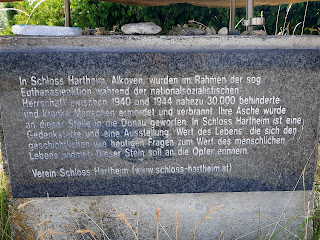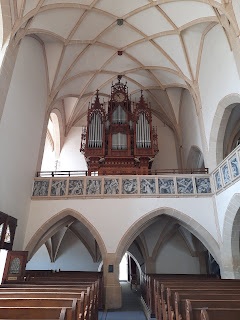Day 5: Eferding to Ottensheim
A mile or so beyond Eferding is the thatched-roofed Scharmüller Häusl, built in 1722 and continuously occupied until 1970. About 33 years ago, S and I played a game of Scrabble in which we allowed German words as long as S told me what they meant and used them in a sentence. Thus one of the first German words I learned from him was Dach, as in "Das Dach ist nicht Reet gedeckt" ("The roof is not reed-covered, i.e. thatched"). Here we see that Das Dach ist Reet gedeckt.After my Day 4 Burgruinen detour, I was back on the Donausteig. For Day 5, to make up for my absence along the river on Day 4, my plan was to follow bike paths along the Danube all the way to Ottensheim.
Here, one last look at the Aschach before switching over to the Donau.
The Donau is wider than the Aschach...
The Danube was the northern border of the Roman Empire. This informational marker had a visiting legionnaire...
Took me about a week, but I finally posted photos of this stone on Facebook, as the stone requested.
I left the Roman legionnaire stone further downstream for someone else to find.
Never forget. The marker below says:
In Hartheim Castle, in Alkoven [a town above the Danube just south of here], as part of the so-called Euthanasia Action during the reign of National Socialism between 1940 and 1944, nearly 30,000 people with disabilities and illnesses were murdered and burned. Their ashes were thrown into the Danube at this location. In Schloss Hartheim is a memorial site and an exhibit, "Value of Life," dedicated to past and present questions about the value of human life. This stone is meant to commemorate the victims. --The Association of Schloss Hartheim (www.schloss-hartheim.at)
I crossed back to the north side of the Danube on foot, on the bridge over a hydroelectric power system and some locks. The signage as I approached made clear that there should be no goofing around here.
The castle on the left bank lies above Ottensheim, the town that was my destination for the day. It's privately owned, so I couldn't get any up-close shots.
Walk walkity walk walk walk. I passed a huge rowing/sculling center that has hosted numerous world championships, and didn't think to take a single photo.
Obligatory organ photos at the 15th-c. late-Gothic/early-Baroque church in Ottensheim:
Note the assymetry:
Ta da! 11.9 miles walked, ~250 elevation gain. You can see the impressive length of the sculling center on the right side of the map. It extends pretty much from the kink in my route just left of the two red dots all the way east to the next kink in my route just to the right of the spit of land extending into the Donau.
I arrived in Ottensheim shortly after noon, thanks to flat terrain plus fewer than usual miles, and my hotel didn't open until 3pm. I decided to eat a quick lunch in Ottensheim, then take the Donau Bus ferry to Linz. The ferry driver saw my backpack and hiking poles and asked if I was hiking the Donausteig--the first person on my trip who seemed familiar with the hiking trails, as opposed to the biking trails--and offered suggestions about which route to hike into Linz the next day.
I spent a few hours wandering around touristy sites in Linz, then caught the ferry back to Ottensheim.
Anton Bruckner was the organist at the Old Cathedral from 1855-1868. The organ he played, originally designed and built by Franz Xaver Chrismann for a different church ca. 1760, moved to Linz in 1790, and was tonally redesigned and expanded by organ builder Leopold Breinbauer according to Bruckner's wishes during his tenure as organist.
I was delighted to be able to see the organ, because most of the big churches I stepped into in Linz looked more like the one below. You can't see the organs if you can't walk in farther than the space under organ loft. Locked gates probably make it hard to meet the needs of folks who want to pray or whose souls need saving, but what do I know...
One of the reasons I was excited to choose Linz as my final destination for my multi-day hike was to follow up on questions about Linzer Torte that arose during our 2009 sabbatical in Freiburg. A lot of signs advertised Original Linzertorte, so I was hard pressed to decide where to buy some. I figured I could decide on Day 6, plus it was very hot on Day 5, so I gave up and instead enjoyed some gelato made from recipes of unknown but probably originally Italian.
The Martin Luther Kirche had text on its inner doors in in-your-face Hebrew, as well as Latin, Greek, and German--but the inner doors were locked nonetheless.
This sign says it's forbidden to post signs here:
The Mariendom, Austria's largest cathedral, was pretty snazzy inside and out. I assumed it was contemporaneous with Freiburg's 13th-c. Muenster and Strassbourg's 13th-c. cathedrals, but it was built in the 1860s, while Bruckner was playing the organ over at the Alter Dom.
Behind the Dom was the cathedral's stonework workshop.
A photo, through a bakery window, of "original Linzer Torte."
The Mozarthaus: Mozart composed the Linzer Symphonie here in just 3 days during a 1783 stopover in Linz.
Christian Doppler, who discovered the Doppler Effect, went to 4th grade here:
Architectural design--or street art--on a building wall a few steps below the Linzer Schloss:
View from the Schloss:
The 15th-c. Martinskirche--another gated church:
Heading back down to Linz from the Schloss...
Views from the Donau Bus...




























.png)





































No comments:
Post a Comment